Mechanochemistry-assisted synthesis of MgO/N-doped biochar from wood waste for synergistic catalysis in rosin esterification
IF 5.6
1区 农林科学
Q1 AGRICULTURAL ENGINEERING
引用次数: 0
Abstract
The development of efficient catalysts for rosin esterification is essential for advancing the high-value utilization of natural rosin, owing to the improvements in its processability. This study focused on the preparation of the magnesium oxide/N-doped biochar (B-MgO-N-C) from wood waste using a mechanochemistry-assisted strategy. Comprehensive characterizations revealed that ball milling together with nitrogen doping facilitated the incorporation of MgO into the carbon matrix, both of which contributed to the improved catalytic activity. The catalytic performance of B-MgO-N-C was then evaluated using the esterification of rosin with glycerol as a model reaction. After optimization, a 94.6 % rosin conversion was achieved at 230 °C over 4 h, outperforming the performance of both MgO-loaded biochar and N-doped biochar catalysts. The enhanced catalytic activity of B-MgO-N-C can be attributed to the synergistic effect of in-situ embedded MgO and N-doping, which increases the number of active sites. CO2-TPD and NH3-TPD studies confirmed the importance of basic sites in promoting the esterification of rosin, whereas acidic sites might also contribute to this process. Moreover, recycling tests demonstrated that N-doping improved the stability of B-MgO-N-C. The catalyst also showed high rosin conversion when other alcohols were used. Accordingly, this work presents a straightforward strategy for designing metal oxides/N-doped biochar as advantageous catalysts for the esterification of rosin.

求助全文
约1分钟内获得全文
求助全文
来源期刊

Industrial Crops and Products
农林科学-农业工程
CiteScore
9.50
自引率
8.50%
发文量
1518
审稿时长
43 days
期刊介绍:
Industrial Crops and Products is an International Journal publishing academic and industrial research on industrial (defined as non-food/non-feed) crops and products. Papers concern both crop-oriented and bio-based materials from crops-oriented research, and should be of interest to an international audience, hypothesis driven, and where comparisons are made statistics performed.
 求助内容:
求助内容: 应助结果提醒方式:
应助结果提醒方式:


